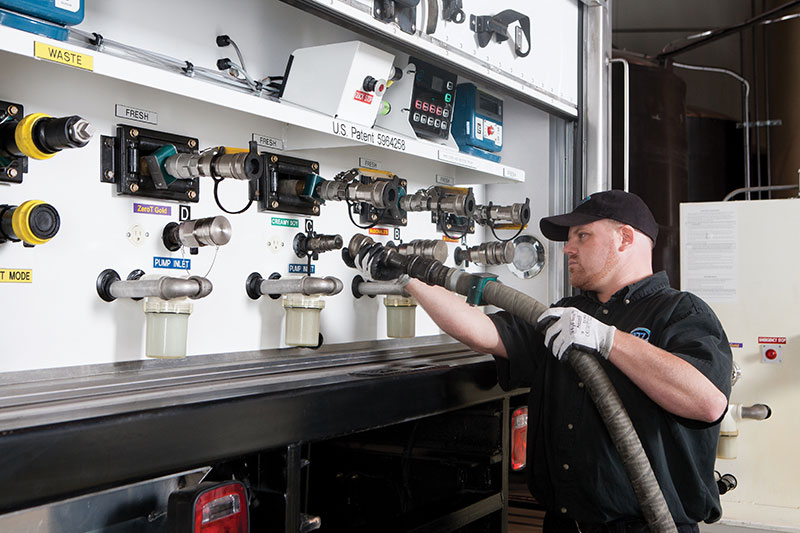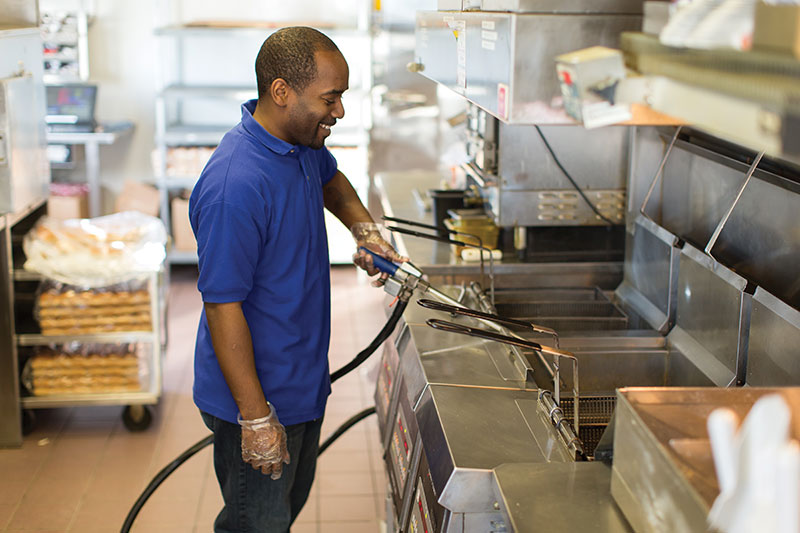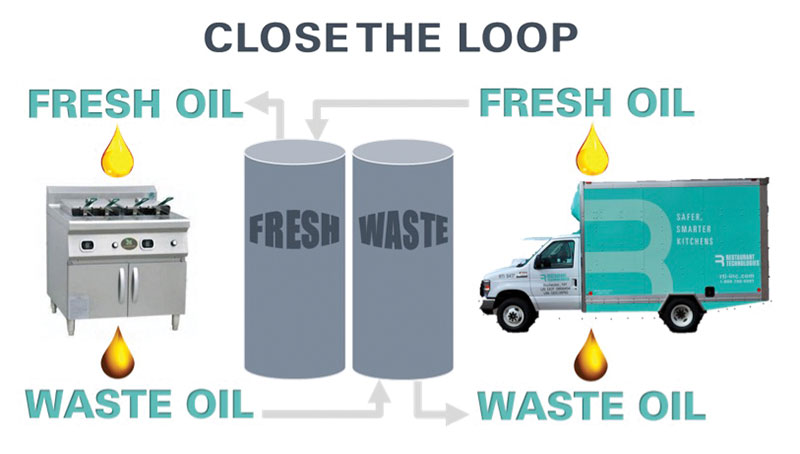Oil Recycling: How to find the hidden gold in your restaurant operation.
By Tina Swanson
Many restaurants have sustainability goals aimed at reducing waste, energy and water use, like using energy-efficient equipment and recycling waste in presorted dumpsters. And according to the National Restaurant Association, an estimated 82% of restaurants participate in recycling and sustainability efforts.1
However, even more can be done to improve facility and business operations. Did you know that 95% of today’s restaurant food waste can also be recycled or composted?2 Common restaurant items such as biodegradable to-go flatware and boxes, cups and lids, eggshells, fruit and vegetable waste, and coffee grounds and coffee filters are all compostable.
Another sustainability opportunity is to recycle used cooking oil, sometimes referred to as yellow grease. In fact, all restaurants are legally required to recycle their cooking oil. Used cooking oil presents a big opportunity for sustainability improvements because of the large amounts produced by the typical quick-service restaurant (QSR):
• 35 pounds of used cooking oil per day, per restaurant3
• 150 to 250 pounds of used cooking oil generated per week per restaurant4
• 249,243,160 gallons of used cooking oil produced per year by all U.S. QSRs5
 Most restaurant operations let the oil cool down, store it in leak-proof containers and call a recycling center in the area for pickup or drop-off — not the most efficient or safe method. The oil can also be recycled through an automated oil management system, which significantly improves kitchen safety and efficiency by eliminating the need to transfer hot waste oil to and from storage locations, to the fryers and rendering tanks. This turnkey technology can reduce oil usage and oil spend, and lowers the amount of cardboard and plastic packaging overcrowding landfills.
Most restaurant operations let the oil cool down, store it in leak-proof containers and call a recycling center in the area for pickup or drop-off — not the most efficient or safe method. The oil can also be recycled through an automated oil management system, which significantly improves kitchen safety and efficiency by eliminating the need to transfer hot waste oil to and from storage locations, to the fryers and rendering tanks. This turnkey technology can reduce oil usage and oil spend, and lowers the amount of cardboard and plastic packaging overcrowding landfills.
Hot Demand
Many recycling centers want used cooking oil so they can convert it to animal feed or to a renewable fuel called biodiesel. Made from vegetable oils, fats or greases from oil-bearing plants, biodiesel can be used in place of petroleum-based fuel in diesel engines in cars or trucks made after 1996, without having to change the engine. It’s typically sold as a blend of biodiesel and petroleum-based diesel fuel called B2O.
When crude oil prices were high — going for $100 a barrel or more — restaurants could earn 50 cents per gallon for their used fryer oil.6 But now that crude oil is going for half of that, the prices have dropped. Still, recycling cooking oil has benefits, and biodiesel has its advantages as a fuel. According to the United States Environmental Protection Agency (U.S. EPA), biodiesel produced from used cooking oil results in an 86% reduction in greenhouse gases, compared to petro-diesel. It typically burns cleaner, does not produce carbon monoxide and helps communities reduce their carbon footprint. It has been tested by and passes the EPA’s Clean Air Health Effects testing requirements. And while it can’t single-handedly solve the world’s energy demands, it certainly helps by offsetting petroleum and reducing carbon emissions. For this reason, it is often used in commercial vehicles, such as buses and garbage trucks.
Many businesses recycle cooking oil for this very purpose. McDonald’s restaurants have been recycling used cooking oil in more than 10,000 locations since 1999. In the United Arab Emirates and in the United Kingdom, McDonald’s even operates its delivery trucks on biodiesel made from its recycled fryer oil.
 A closed-loop oil management system makes it easy for restaurant facility managers to dispose of used cooking oil by picking it up when the company brings fresh oil. It then sells most of its used cooking oil to the Iowa-based Renewable Energy Group, one of the largest biodiesel producers in the world.
A closed-loop oil management system makes it easy for restaurant facility managers to dispose of used cooking oil by picking it up when the company brings fresh oil. It then sells most of its used cooking oil to the Iowa-based Renewable Energy Group, one of the largest biodiesel producers in the world.
Many oil management and oil recycling companies have program models that include rebates for used cooking oil.
Saving the Planet, One Container at a Time
For restaurants, recycling used cooking oil can be a small cost-saving measure. Not disposing of the cardboard and plastic containers that typically hold the oil reduces the number of trash pickups. In 2015 alone, we helped eliminate more than 10 million plastic and 10 million cardboard containers from landfills, saving 7.5 million cubic feet of landfill space through automated oil management solutions. Shake Shack avoided the disposal of 24,384 pounds of trash, the equivalent of what 124 dumpsters hold, simply by eliminating packaging from the manual oil management process.7
In addition to the opportunity for turning used cooking oil into biodiesel, there is another way that recycling this oil contributes to a greener environment: by keeping it out of the water supply. Although restaurants are required to recycle oil, employees short on time sometimes pour used oil down the kitchen drain, which clogs plumbing, blocks sewer lines and contaminates the water supply. Recycling the oil can prevent costly FOG fines and backups that often require a plumber to clear.
 Recycling used cooking oil is a great way to bolster your sustainability initiatives and support your company’s eco-minded values. Raise awareness of your actions by encouraging employees to share your sustainability story with customers. It’s one thing to jump on a trend; it’s quite another to lead by example.
Recycling used cooking oil is a great way to bolster your sustainability initiatives and support your company’s eco-minded values. Raise awareness of your actions by encouraging employees to share your sustainability story with customers. It’s one thing to jump on a trend; it’s quite another to lead by example.
Sources:
1 Helen Kelley, “How Green Grows Your Restaurant? Create a Plan for Your Current and Future Sustainability,” Waste Cost Solutions, February 26, 2015, http://www.wastecostsolutions.com/blog/how-green-grows-your-restaurant-create-a-sustainability-plan (accessed August 12, 2016).
2 Green Restaurant Association, http://www.dinegreen.com/#!waste/qgv2b (accessed August 12, 2016).
3 “How Much Grease Fast Food Restaurants Produce,” http://www.waterindustry.org/Water-Facts/FOG-1.htm (accessed August 12, 2016).
4 Ibid.
5 Ibid.
6 Natalie O’Neill, “Fry-oil biofuel businesses suffer as gas prices fall,” New York Post, http://nypost.com/2015/01/02/fry-oil-biofuel-businesses-suffer-as-gas-prices-fall/ (accessed August 16, 2016).
7 “Shake Shack: Restaurant’s Strong Partnerships Are the Recipe for Success,” https://www.rti-inc.com/wp-content/uploads/2016/03/ShakeShack_CaseStudy_March2016.pdf (accessed August 22, 2016).
— Tina Swanson joined Restaurant Technologies in 2012 and currently leads the customer experience, account management and sales teams in order to maximize oil management and handling at each restaurant facility.
